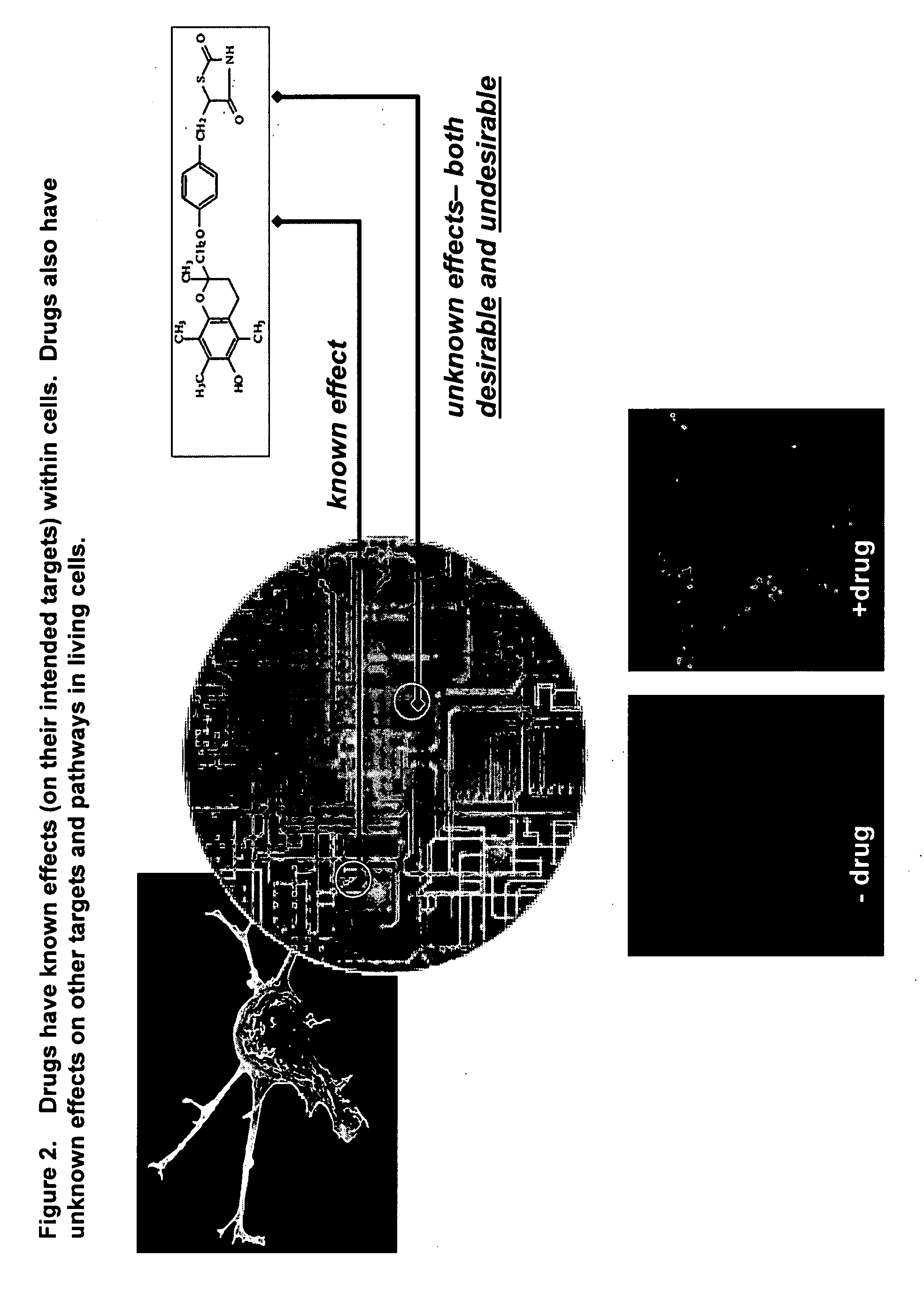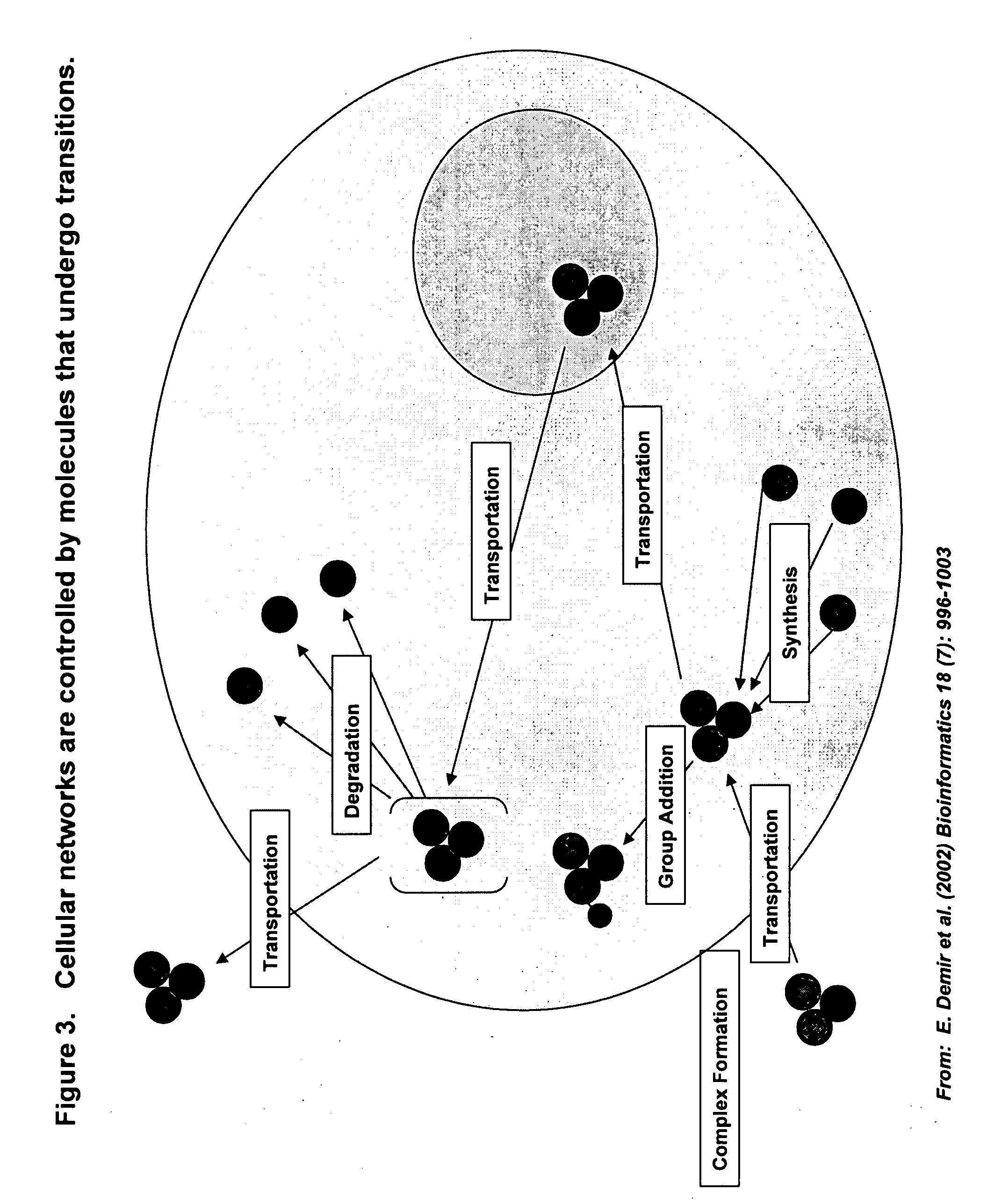Identifying off-target effects and hidden phenotypes of drugs in human cells
a technology of applied in the field of identifying off-target effects and hidden phenotypes of drugs in human cells, can solve the problems of high pre-clinical and clinical failure costs, difficult development of selective inhibitors, and high cost of new drugs
- Summary
- Abstract
- Description
- Claims
- Application Information
AI Technical Summary
Benefits of technology
Problems solved by technology
Method used
Image
Examples
example 1
[0165] In the first example, modification-state-specific antibodies were used to probe pathways within human cells. We created panels of quantitative, fluorescence assays for different states in live cells, where each state was a phosphoprotein, and tested the activities of known agents against the assay panels. We used fluorescence microscopy in combination with image analysis, such that the sub-cellular localization of each state could be assessed, enabling automated, “high-content” analyses. Specifically we assessed changes in the phosphorylation status of the pathway ‘sentinels’ by constructing high-content, immunofluorescence assays using phospho-specific antibodies targeted to the downstream proteins in the pathways of interest. Flow cytometry and fluorescence spectroscopy can also be used for this purpose, in cases where spatial resolution of the signal is not required. We demonstrate that the pattern of responses or “pharmacological profiles” detected by changes in intensity...
example 2
[0176] Here we demonstrate that both predicted and novel effects of known drugs and inhibitors can be deduced using the present invention (FIGS. 13-19). To represent a diversity of human cellular pathways, we created cell-based assays for 49 different states, where each state was a dynamic protein-protein complex representing one of the following processes: cell cycle control, DNA damage response, apoptosis, GPCR signalling, molecular chaperone interactions, cytoskeletal regulation, proteasomal degradation, mitogenesis, inflammation, and nuclear hormone receptor activation. The assays engineered for this study were protein-fragment complementation assays (PCAs) based on an intensely fluorescent mutant of YFP. We chose this reporter because the intense levels of autofluorescence allow the detection of complexes between full-length proteins expressed at low levels in human cells and the reconstituted YFP matures rapidly (9 minutes) allowing for detection of early effects on protein co...
example 3
[0195] Small interfering RNA (siRNA) represents an exciting new chemical class of compounds for human therapeutics. The first human clinical trials of an siRNA compound are now in progress. The technology of RNA interference (RNAi) also represents a breakthrough in efforts to identify, validate and link genes to specific cellular processes and to identify optimal targets for the development of human therapeutics. In addition to studying the functional consequences of gene targeting in living cells, the ultimate goal of such studies is to understand the biochemical connection between the target that is silenced and the effect that is observed. RNAi strategies rely on the property of double-stranded RNA (dsRNA) to activate the endogenous cellular process of highly specific RNA degradation, and are generally employed to link specific genes to their functional roles within the cellular signaling network and to identify proteins of potential therapeutic or diagnostic relevance. However, ...
PUM
| Property | Measurement | Unit |
|---|---|---|
| time | aaaaa | aaaaa |
| wavelengths | aaaaa | aaaaa |
| distance | aaaaa | aaaaa |
Abstract
Description
Claims
Application Information
 Login to View More
Login to View More - R&D
- Intellectual Property
- Life Sciences
- Materials
- Tech Scout
- Unparalleled Data Quality
- Higher Quality Content
- 60% Fewer Hallucinations
Browse by: Latest US Patents, China's latest patents, Technical Efficacy Thesaurus, Application Domain, Technology Topic, Popular Technical Reports.
© 2025 PatSnap. All rights reserved.Legal|Privacy policy|Modern Slavery Act Transparency Statement|Sitemap|About US| Contact US: help@patsnap.com



